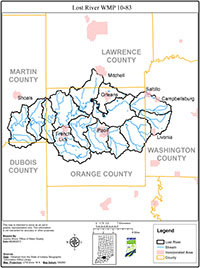Summary
The Lost River flow comes from land that is part of Washington, Orange, Lawrence, Martin, and Dubois Counties in Indiana. The headwaters of Lost River originate in western Washington County, Indiana. Lost River generally flows west into Orange County to a point where it sinks underground into the karst caverns below. Lick Creek and French Lick Creek join Lost River once it reemerges from the cave system though a series of springs. The water movement continues in the westward direction where it bisects the landscape with narrow meandering valleys through Martin County. Many small side tributaries contribute to Lost River as it traverses this terrain. Lost River completes its journey to the East Fork of White River. Many karst springs keep water flowing year-round within many portions of the watershed.
As part of this project stakeholder water quality concerns were collected at public and steering committee meetings and solicited by steering committee members. The steering committee determined whether each concern was supported by available data then identified specific problems relating to each concern that was supported by data and on which the group wished to focus. Problems were defined as issues that exist due to a concern. Specific problems were consolidated into problem categories. Identified problem categories include high stream nutrient levels, high TSS and turbidity levels, high stream E. coli levels, low oxygen levels, low pH levels, degraded aquatic habitat, flooding, trash, reduced aquatic recreation, and decreased aquatic biodiversity.
A total of 27 sample sites were established within the watershed as part of this study. Data collected included temperature, pH, specific conductivity, dissolved oxygen, biochemical oxygen demand, total phosphorus, orthophosphate phosphorus, nitrate, total suspended solids (TSS), turbidity, discharge, E. coli, macroinvertebrate communities, and habitat data.
The plan includes goals, defined critical areas, suggested practices, and an action register for implementation and meets the 2009 checklist.

